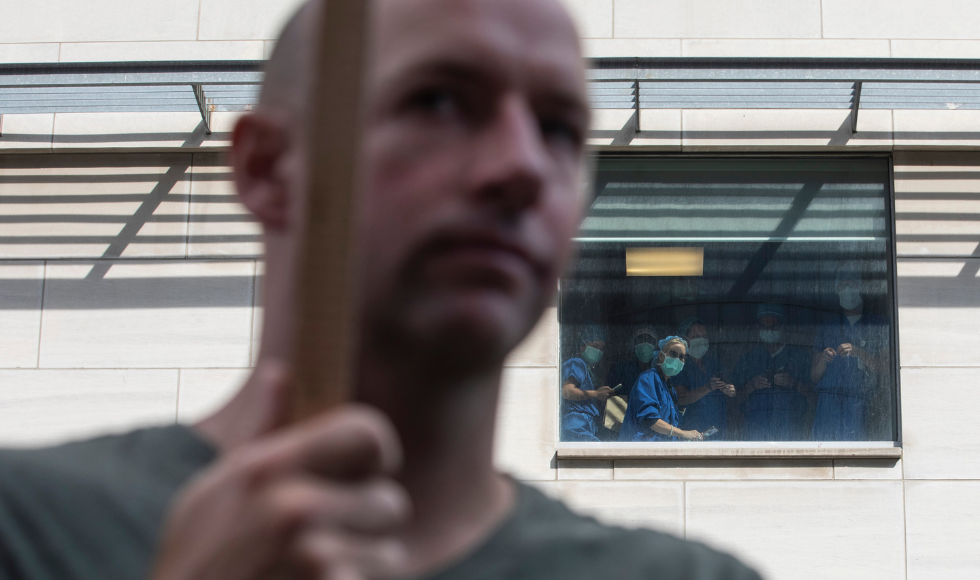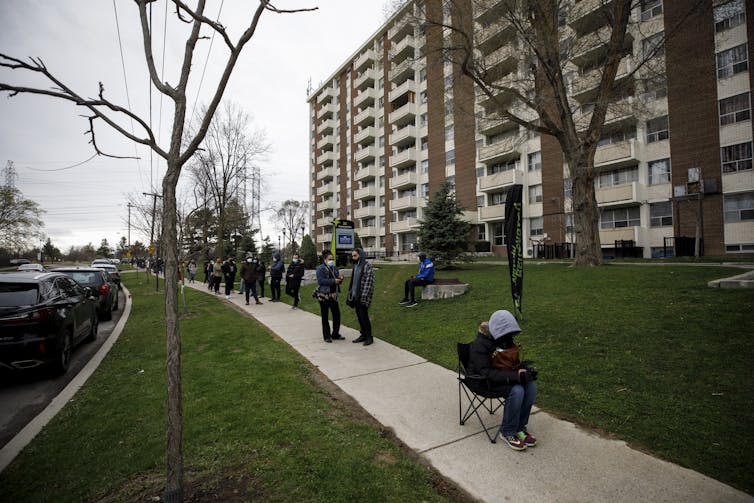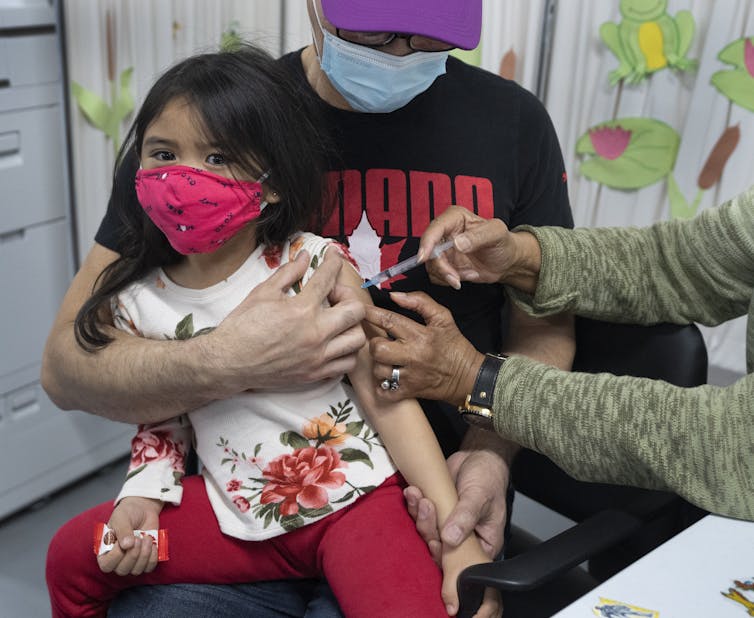Analysis: Politicizing COVID-19 vaccination efforts has fuelled vaccine hesitancy

Health-care workers watch from a window as demonstrators gather outside Toronto General Hospital in September 2021 to protest against COVID-19 vaccines, mandates and restrictions. (The Canadian Press/Chris Young)
BY Zain Chagla, McMaster University; Kwadwo Kyeremanteng, L’Université d’Ottawa/University of Ottawa; Stefan Baral, Johns Hopkins University
February 2, 2022
The current political landscape has become increasingly intertwined with vaccine policy.
Platforms from political parties have included vaccine mandates, third-dose policies and mandatory vaccination proposals aimed at children. Québec has even proposed taxing people who remain unvaccinated.
This is concerning, particularly given that vaccination efforts are driven by the combined efforts of health-care providers, public health agencies and community leaders.
We’re clinical providers who have implemented vaccination programs from the time they were first available, and we recognize how profoundly vaccines reduce the severity of COVID-19. Based on our experiences running vaccine programs, we have concerns about the use of increasingly punitive policies towards people who remain unvaccinated.
While many equate vaccine mandates with vaccine uptake, much of the work was done prior to imposing mandates. In Ontario, for example, 77 per cent of the population 12 and up had already received two doses when the proof-of-vaccination requirement was announced on Sept. 1, 2021. That number only rose another 12 per cent to 89 per cent as of late January 2022.
In keeping with traditional public health practice, proactive community engagement, counselling and outreach has resulted in the vast majority of vaccinations provincially, a fact easily lost in the rhetoric of politicians.
‘Booster Games’
Those grassroots efforts need to be put in place in order to maximize third doses proactively, too. Ontario’s booster rollout amid the Omicron wave has been widely criticized as a “Hunger Games” approach, favouring those who could stand in long queues or refresh their Twitter accounts. Only 75 per cent of adults over the age of 70 have been able to access a booster to date.
This is a large gap among those who most benefit from the booster, suggesting more outreach efforts are needed. In Ontario, the third-dose rate in those experiencing homelessness is only 32 per cent for people over 65 and 10 per cent for those under 65, according to provincial data.
Even within Toronto, the same data shows the wealthy Rosedale neighbourhood has a third-dose rate of 50 per cent while it’s 16 per cent in the working-class Jane-Finch area.

These findings are consistent with data from the United States suggesting racialized communities have the lowest rate of vaccine uptake.
This means structural barriers clearly need to be addressed before third doses are mandated. Further enforcement could lead to more hesitancy and create deeper divides and segregation among vulnerable communities.
Disparities among children, too
In children, the same differences arise, despite growing calls for vaccine mandates in schools. There is a much higher vaccine uptake in richer communities than in poorer ones. In Ontario, two-dose vaccination rates in 12- to 17-year-olds in the poorest communities is 20 per cent lower than in the richest.
As a society, are we willing to keep the most economically disadvantaged out of school over vaccination given the snowball effects from prolonged lack of in-class education, especially among communities where education may be the road out of poverty?
While some may cite the mandatory immunizations required for schools, many of the vaccines on the list had decades of clinical experience prior to being mandated. The COVID-19 vaccine in five- to 11-year-old children has been approved in Canada for only three months, and while all data points to it being both safe and effective, even our National Advisory Committee on Immunizations notes:
“Parents are supported and respected in their decisions regarding COVID-19 vaccinations for their children, whatever decisions they make, and are not stigmatized for accepting, or not accepting, the vaccination offer.”
Importantly, two doses of vaccine remain highly protective against severe disease among most people. Should an 18-year-old with two doses, with a hospitalization risk of 0.1 per cent with two doses according to data compiled in British Columbia, be excluded from society because a third dose reduces personal risk to even less than 0.1 per cent?
Efficacy decline?
It is still unclear if protection from booster shots wanes over time, with a recent British report suggesting a decline in efficacy to 40 per cent against infection 15 weeks after people get boosters.
Finally, there’s the prospect of infection-derived immunity. Nearly 50 per cent of people in certain regions are expected to be infected with COVID-19 in the coming weeks. U.K. data suggests those with two doses of vaccine plus infection-derived immunity show similar protection to three doses and no infection.
Health-care practitioners and community leaders who encourage and empower their patients and community to get vaccinated comprise a sustainable, positive health intervention. It reinforces the therapeutic bond between health-care providers and patients. Politicians attempting to force those patients to get third doses run the risk of eroding this trust.
What’s more, as the pandemic endures, what happens when a newer generation of vaccines arises that are required for the population to reach optimal immunity?
What happens if a pan-coronavirus vaccine is made available?
Given the divisions created by vaccine mandates, the use of these future tools may be significantly compromised if we push people too hard now.
Politicians fuelling division
The antagonism that’s being created by political interference risks fuelling hesitancy even further. COVID-19 isn’t going to be the last pandemic or public health emergency necessitating public buy-in, and any gains with mandating third doses may lead to challenges in long-term engagement with the primary consumer of public health — the public.
During the English leaders’ debate during last fall’s federal election, five leadership candidates came together to encourage vaccination across the political spectrum.
We all agree, vaccines save lives and will be key to defeating the COVID-19 pandemic.
If you haven’t already, get the shot!#VaccinesSaveLives pic.twitter.com/v42MghNHn9
— Annamie Paul (@AnnamiePaul) September 10, 2021
It was a moment of unity in health promotion messaging in Canada.
Today, government and opposition leaders should promote policies to increase resources for proactive uptake and outreach that encourages vaccination and empowers people, rather than basing policies in mandates and penalties.
Health-care providers, public health organizations and community leaders should be a positive force in vaccination. To ensure success, policies should be driven by community engagement, empowerment, equity and education.
Do you have a question about COVID-19 vaccines? Email us at ca-vaccination@theconversation.com and vaccine experts will answer questions in upcoming articles.![]()
Zain Chagla, Associate Professor, Division of Infectious Diseases, Department of Medicine, McMaster University; Kwadwo Kyeremanteng, Associate Professor, Department of Medicine, L’Université d’Ottawa/University of Ottawa, and Stefan Baral, Professor, Department of Epidemiology, Johns Hopkins School of Public Health, Johns Hopkins University. This article is republished from The Conversation under a Creative Commons license. Read the original article.



